Posts
-
Let's Read the 4e Monster Manual/Vault: Human
As we saw in the Monster Manual Let’s Read, Fourth Edition makes the usual D&D human description a little more specific. They’re the mortal people without a patron deity, which makes their outlooks on life very varied and leaves extra room in their hearts that can be filled with extreme dedication to any number of causes. Therefore, humans can produce some of the world’s greatest heroes as well as its most depraved villains.
This MM2 entry brings us a huge grab bag of human stat blocks. Most of them are the usual Unaligned people that can be repurposed as either allies or enemies, but a few are Evil or Chaotic Evil and meant to always be used as threats.
Numbers-wise, they have absolutely no common traits beyond being Medium Natural Humanoids with a ground speed of 6. You can easily take a human stat block and make it into a member of another species by adding the relevant signature ability to them (Goblin Tactics, Elven Accuracy, Savage Demise, Fey Step…).
Human Cavalier
An armored knight that fights with lance and sword. It’s highly recommended that you give them a mount when building your encounters, though they can give a good account of themselves on foot as well. Horses and griffons are the most common cavalier mounts.
The Cavalier is a Level 7 Soldier (Leader) with 78 HP. Their basic attack is a sword strike that damages and marks on a hit, and they can exploit the mark with two different interrupt abilities. Champion’s Retort is at-will and allows the knight to make a slightly weaker attack against a marked enemy who decides to ignore the mark. Hasty Parry is an encounter power that forces the enemy to target the knight instead, and gives the knight a +3 AC bonus against that attack.
When mounted, the knight can also attack with a Lance that damages and knocks prone on a hit. The text doesn’t say it can be used as part of a charge, but it really should have this ability.
Human Diabolist
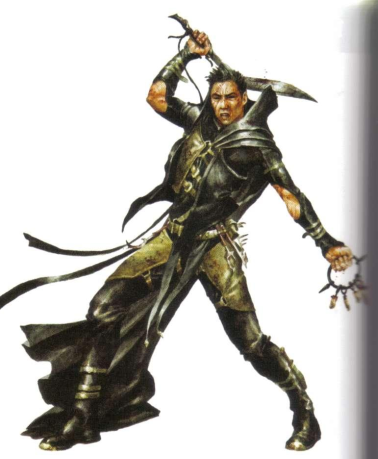
Copyright 2009 Wizards of the Coast A warlock-type who’s in tight with the forces of Hell, and wields fire-and-brimstone themed magic to achieve their Evil ends.
The diabolist is Level 20 Artillery with 147 HP, powerful enough to be encountered alongside groups of high-end devils. Their main weapon and implement is a kukri that does a mix of physical and fire damage. Like all attacks in this book it needs a damage boost, but make sure its roll is still a fistful of d6s because this attack has the Brutal property. This means you re-roll any dice that show a 1 until they show something else.
Their attack magic is all about Darkfire, in an “at-will single-target” and “area encounter power” versions. It does fire and necrotic damage, and the area version also does ongoing fire and necrotic damage (save ends).
For enemies who get a bit closer, the diabolist can use a Sulfurous Flash attack that deals fire damage and gives the caster concealment against the target until the end of the caster’s next turn. If attacked, the diabolist can use Infernal Deflection (recharge 5+) as an interrupt to take half damage from the attack and deal an automatic 15 fire damage to the attacker.
All of these attacks can be enhanced by Hell Blight, a minor action that automatically makes an enemy in sight “blighted”. If a blighted enemy takes fire damage from the diabolist, they can’t recover HP until the end of the diabolist’s next turn. The blight ends when the fight does, or when the diabolist blights someone else. This makes focusing their fire on a sincle PC at a time a very effective tactic.
Finally, the Life From Fire passive trait gives the diabolist 10 temporary HP whenever they take fire damage from any source.
Human Dire Beast Hunter
Someone has to protect all those scattered villages if no PCs are around to help! This hunter is Level 9 Artillery with 76 HP, wielding a spear, a crossbow with poisoned bolts, and a net.
The net is a Ranged 3 attack that does no damage and restrains (save ends). The crossbow has good range and its bolts have an ongoing poison damage (save ends) rider. The spear is there for emergencies, because its best to hunt dire beasts from a distance.
The hunter is not meant to be alone. It should be encountered either as part of a sizable NPC hunting party, or attached to the PCs as an ally for a particularly tough hunt.
Human Dread Assassin
An epic-level assassin armed with a dreadful sword and with spells of poison and darkness. The perfect person for the job when that job is to kill a king or emperor. Though they’re unaligned, their clientele is unlikely to be very nice.
The assassin is a Level 22 Lurker with 161 HP and a speed of 7. Their Zealot’s Scimitar is a High-Crit weapon that also deals ongoing poison and necrotic damage (save ends). They can use a power named Cloak of Zeal as a move action to shift 3 squares and gain concealment until the end of their next turn.
While the assassin has cover or concealment, they can use Deadly Blade (recharge 5+) as a minor action to make is so their next attack has combat advantage and deals 5d6 extra damage on a hit. And finally, Assassin’s Determination triggers when they’re bloodied and either immediately recharges Deadly Blade or (if it’s charged already) heals them for 20 HP.
I guess the idea is that this is a deadly foe that will never stop trying to kill you until they succeed, but you should really boost their damage for that to be true. Also, since they’re regulars you should expect these epic ninjas to team up with either other assassins, or with some distracting heavies.
Human Gladiator
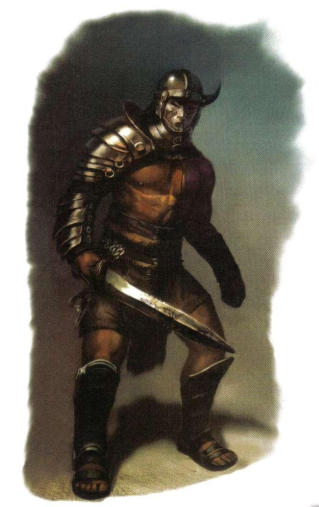
Copyright 2009 Wizards of the Coast This gladiator is described by the book as a “consumate athlete”, which isn’t really the term I’d use to refer to someone forced to fight in deathmatches for the amusement of a bloodthirsty crowd. Still, some of them might end up becomming bloodsport celebrities, and this one is powerful enough to fit that role.
This particular individual is a Level 14 Elite Soldier with 276 HP, so we’re either looking at a Spartacus in the making or at the reigning champion of the arena that must be taken down before the revolt can start. He wears armor equivalent to scale and carries a light shield and a gladius.
The gladiator has a Fighting Focus aura (1) that marks enemies who start their turns inside, lasting until the start of their next turns. It’s a lot like the Essential Knight’s Defender Aura, with a bit more stickiness.
That gladius can be used to make melee basic attacks, and in a Gladius Display that attacks a Close Burst 1 and does the same damage. This is supplemented by a variety of dirty tricks. They’re all minor actions, and though none of them do damage they inflict a variety of conditions.
Knock to the Dirt is an encounter power that targets Fortitude and knocks prone; Sand in the Eyes is another encounter power that targets fortitude, and causes blindness (save ends). Well-Placed Kick is recharge 5+, targets Reflex, and both slows and dazes the target (save ends). I bet it targets the… knee. Yeah, that’d do it.
That’s the sort of fighting style that’d mark you as a heel in wrestling, but since the gladiator fights in actual life or death matches I’d say it’s just good sense.
Human Hexer
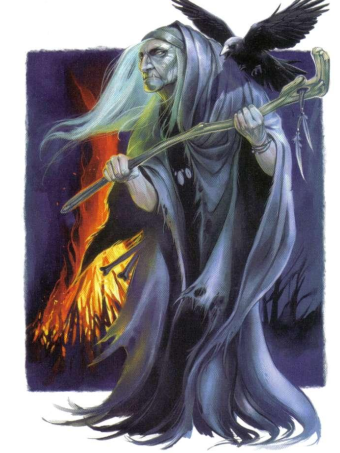
Copyright 2009 Wizards of the Coast Perfect for playing the part of a sinister witch or a seer whose dire prophecies go unheard. The hexer is a Level 7 Controller with 77 HP, wearing robes and wielding a staff.
The hexer is extremely weak in terms of damage, and is meant to be used alongside monsters who are better in that area. They have some interesting control options, though.
Their only melee attack is a weak bonk with the staff, but insted of bothering with it they’re going to stay away and open up with Hex, a minor action that targets all enemies in a Close Burst 10. That’s guaranteed to cover all PCs unless one of them is a sniper ranger or something. It’s an attack against Will, and a hit means the target is hexed. Hexed targets have a -2 penalty to damage the hexer, and become valid targets for the hexer’s other spells.
One of them is Capricious Earth (encounter), a big area burst that targets Will, does a bit of damage, slides targets 3 squares, and knocks them prone.
The other one is Beast Curse (recharge 4+), a ranged spell that targets Fortitude and turns the target into a Tiny creature until the end of the hexer’s next turn. While in this state the target cannot use powers. Yes, this does include basic attacks, so your Slayer won’t turn into a surprisingly deadly frog.
Human Insane Noble
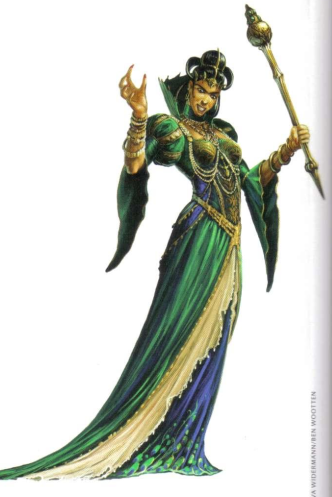
Copyright 2009 Wizards of the Coast Not to be confused with the standard Human Noble, shown later. The picture is pretty much a caricature of Carlota Joaquina, a historical figure who was rather unpleasant but not epic-level.
The Insane Noble wears finery and wields a scepter, but as a Level 23 Elite Skirmisher it doesn’t need much more than that to ruin your day. Sheer Madness makes them immune to opportunity attacks. The scepter is a basic attack, and Flurry of Madness allows the noble to shift 6 squares and make a scepter attack against every enemy they pass by during the shift. These traits and abilities combine to make them a combatant that never stands still, scuttling about the battlefield with alarming alacrity.
When the noble is first bloodied, Ignoble Fury triggers and lets them bonk everyone in a Close Burst 1 with a scepter attack that also knocks targets prone on a hit.
Human Javelin Dancer
A specialized martial artist, lightly armored and wielding a spear for close combat and a brace of javelins for range. Their Skirmisher trait allows them to do increased damage if they move at least 4 squares before attacking, and Adept Retreat makes them not grant combat advantage when running. “Running” is something everyone can do, greatly increasing their Move at the cost of granting combat advantage. That’s what the dancer ignores.
In addition to basic attacks with the spear or a thrown javelin, the dancer can also make a Mobile Attack at will, shifting 3 squares and attacking with the spear.
Human Knife Fighter
Knife fighters are rogue-types that are much more focused on acrobatic stabbing than on other types of crime, which makes them quite similar to PC rogues when you think about it. They also do well in the role of a knife-focused martial artist, or the classic super-dangerous lieutenant for a criminal gang whose actual boss isn’t a fighter.
This knife fighter is a Level 7 Elite Skirmisher with 162 HP. They go unarmored (which doesn’t affect their defenses, since they’re all based on level), and are equipped with a dagger and a net.
The net is probably a typo, since none of the fighter’s abilities use it, but the knife is a Wounding Dagger with an ongoing damage rider and the High-Crit property. It can also be used in an attack named Dance of the Knife, where the knife fighter makes two dagger attacks and shifts 2 squares between them.
All of these attacks deal extra damage when they have combat advantage, and they can also use Peerless Tumbler (recharge 5+) to shift 4 squares while ignoring difficult terrain.
Very skirmishery, and goes very well with a pack of soldier monsters with marking and punishing abilities.
Human Mystagogue
A divine spellcaster who delves into divine mysteries few mortals can understand. Their magic focuses a lot on mind- and perception-affecting effects.
Mystagogues are Level 20 Controllers with the Leader keyword and 188 HP. They wear robes and carry a holy symbol - all of their attacks are magic.
The basic melee attack is Mystery’s Touch (vs. Reflex), which deals psychic damage and inflicts a -2 penalty to attack the mystagogue until the end if their next turn. At range they use Bend Perception (ranged 20 vs. Will), which deals psychic damage, slows, and inflicts a -2 penalty to all attacks and saves until the end of the mystagogue’s next turn.
Their special attack is Awestrike (close burst 5 vs will), which does the same damage as Bend Perception to all it hits, and also slides the targets 6 squares and dazes them (save ends). The mystagogue also chooses one ally in the area to slide 6 squares and heal for 10 HP.
Finally, the mystagogue can use a Veil of Inscrutability as a reaction to being hit by a melee or ranged attack. This allows them to shift 2 squares and gain a +2 bonus to AC and Reflex for a turn.
As opposition, mystagogues pair well with enemies who can exploit combat advantage or (save ends) effects.
Human Noble
Not to be confused with the Insane Noble from a few entries ago. This type of noble can still be pretty horrible, but not the “epic-level scuttling nightmare” kind of horrible. They’re Level 5 Controllers with the Leader keyword and 60 HP.
The Noble wears mail and wields a longsword and a light shield. Their sword strikes are nothing special, and their actual superpower is ordering people around. It’s very much meant to be encountered alongside its bodyguard detail, which will be made up of more competent fighters. In other words, this is the NPC version of the Lazy Warlord.
The noble is Protected by their allies, and gains a +2 to all defenses when adjacent to at least one of them. Appoint Champion is an at-will order that allows an ally to make a basic attack and shift 1 square before or after it. Inspirational Authority is an encounter power that allows one of those allies to use any of their attacks as a free action.
The noble can also order enemies around. Urge Hesitation is an attack against Will that, on a hit, prevents the target from using a standard action in its next turn.
Human Pirate
Yarrr! Pirates are Level 9 Skirmishers with 95 HP, armed with cutlasses. They’re pretty fast, with a Speed of 7 and a Rigging Monkey ability that gives them a climb speed of 7 for a turn once per encounter.
Their basic attack is a Cutlass strike with no additional riders, but they’re extra-good at flanking: Scurvy Dog’s Flank gives them an extra +1 to hit and +2d6 bonus damage to all attacks against a flanked target. This stacks with combat advantage for a total of +3 to hit.
Their tactics section says they like to stay near the water or near the edge of the boat if this is a boarding action, but I see no reason for this.
Human Pirate Captain
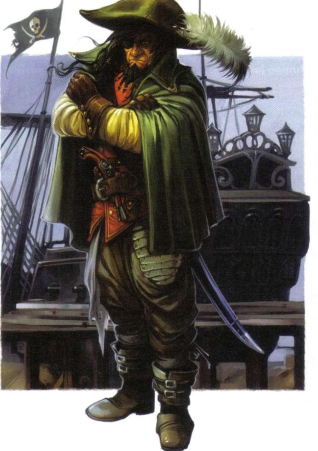
Copyright 2009 Wizards of the Coast Double Yarrr! The captain is a Level 10 Soldier with the Leader keyword and 104 HP. It’s clearly meant to be used alongside a bunch of Pirates and perhaps a small horde of minions.
Their Cutlass attacks have a slow (save ends) rider, and they have the same Rigging Monkey and Scurvy Dog’s Flank abilities as the rest of the crew. Captains complement their swordplay with occasional bouts of Vicious Mockery (minor action; recharge 6+). This doesn’t require an attack roll and causes a nearby enemy to provoke an opportunity attack from one of the captain’s allies. When first bloodied, they shout out a Call to Arms that allows all allies within 10 squares to make a basic melee attack or shift 3 squares as a free action.
Human Slaver
One of the few explicitly Evil stat blocks in this entry, the slaver is an unpleasant villain that fights with a mace and a scourge. Their focus is on immobilizing enemies for capture, and on inflicting pain. They’re level 8 Brutes with 102 HP.
Their basic attack is Thump and Lash, which deals damage and inflicts a -2 attack penalty for a turn. They can also use the scourge to perform a Slaver’s Tangle maneuver (recharge 4+) that does all of the above and also immobilizes for a turn.
Slavers are meant to be use as part of larger capture teams featuring one or more of them plus an assortment of other goons.
Final Impressions
Between the first Monster Manual, the Vault, and the MM2, you have enough human stat blocks that you can include one or more of them in any encounter that demands sapient humanoid opposition. The PCs themselves are proof that humans work well with members of any other sapient species that share their individual goals.
These “generic” stat blocks also work as seasoning for more specialized groups, like cultists. It might surprise the PCs a bit if the guy holding the sacrificial dagger is an elite knife-fighter instead of a squishy caster, for example.
-
Let's Read the 4e Monster Manual 2: Homunculus
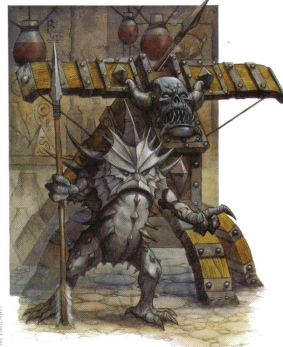
Copyright 2009 Wizards of the Coast The first Monster Manual included an Homunculus entry. The MM2 has a few more, which we’ll look at now.
As mentioned in the original post, homunculi are relatively simple constructs distantly related to golems, the model rocket to the golem’s Saturn V. They’re much weaker but also much simpler to make, and their construction includes some programming shortcuts that make them good at being guards. There are specific shortcuts to guard an object, a creature, or an area. Homunculi are quite intelligent and clever when fulfilling the tasks they were designed for, but are not good for anything else.
In this entry we meet two new homunculus models.
Stonefist Defender
This Small, spiky animated statue is built to act as a bodyguard and combat buddy to a living creature. Its programming makes it very good a coordinating with its “client” during a fight. I imagine a society with plenty of access to magic would build mass quantities of them for use as “combat drones”, supplementing infantry or scouts.
The defender is a Level 2 Skirmisher with 38 HP. It has darkvision, runs at a nice speed of 8, and is immune to disease and poison. It’s surprisingly acrobatic: it can Tumble as an at-will move action to shift 3 squares instead of the usual 1.
The defender’s only attack is a Spiked Fist that’s pretty average on its own, but gains all sorts of situational bonuses when the creature fights according to its programming: by using its high mobility to flank enemies engaged with its “client”. It has a +2 bonus to hit enemies adjacent to the client, and gains +1d6 bonus damage when flanking those enemies.
Arbalester
Arbalesters are animated ballistas! They can move around using wheels or legs, and reload themselves. They’re used as mobile turrets, and can be ordered to watch over a specific area. That same magic-rich society that makes defenders could have arbalesters helping defend fortresses or following patrols around as mobile artillery pieces.
Arbalesters are Level 4 Artillery with 43 HP. They move around at Speed 6, and have the standard traits of darkvision and immunity to disease and poison. They’ll attack with improvised slams if pressed into melee, but their Bolts are of course a much better option. They can temporarily increase their rate of fire to make a Double Shot (recharge 4+), firing bolts at two targets within 5 squares of each other.
They can be set to Guard an Area 5 squares on a side. If any enemy is within this area when the arbalester starts its turn, Double Shot recharges automatically. Their use as defensive turrets is obvious, but they can also be used offensively if transported within range of enemy positions and ordered to “guard” those positions. This will cause them to rain bolts upon those areas until no enemies remain.
Sample Encounters and Final Impressions
Our sample encounter is Level 3: 3 stonefist defenders, 1 arbalester, and a dwarf hammerer. This is obviously a military squad from that magic-rich civ - an organic officer, and his drone complement.
Thinking of these two homunculus models as military drones makes them seem quite interesting as opposition.
-
Let's Read the 4e Monster Manual 2: Hawk
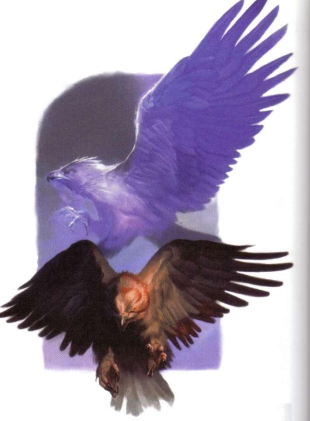
Copyright 2009 Wizards of the Coast Hawks are real world animals, and though they are birds of prey they’re fairly small and don’t usually attack people. For these reasons, 4e doesn’t consider them “monster material”, and this entry focuses on supernatural hawks that can pose a bigger threat to adventurers.
Blood Hawks
As Small Natural Beasts, Blood Hawks are bloody enormous for hawks. They’re also a lot more aggressive than usual, and their claws deal wounds that bleed profusely. This, and their reddish coloration, gives them their name.
A blood hawk is a Level 1 Skirmisher with 27 HP. It has a flight speed of 6, and a ground speed of only 2 (and it’s Clumsy while walking). Its basic attack is a Claw Rake that deals standard physical damage and inflicts 2 ongoing damage (save ends). This ongoing damage raises to 5 if the hawk is bloodied.
The blood hawk can also make Flyby Attacks at will. This follows the standard rules seen in other monsters: it flies its speed, makes a basic attack at any point, and doesn’t provoke opportunity attacks when moving away from the target.
Frost Hawk
A Small Elemental Beast native to certain ice-aspected regions of the Elemental Chaos, the Frost Hawk can also be found in mountaintops and other cold places of the world. It’s a Level 7 Skirmisher with 80 HP, making it a lot more formidable than any mundane hawk. Its flight speed is 8, and its ground speed a clumsy 2. It has Resist Cold 10.
The hawk’s Ice Talons serve as its basic attack, dealing a mix of physical and cold damage. It has the same Flyby Attack as the blood hawk, and it adds a couple elemental powers to its arsenal. Freezing Screech is a Close Blast 3 vs. Fortitude that deals cold damage and slows (save ends). Shattering Strike is a passive trait that make all its attacks deal extra damage against slowed targets.
So a frost hawk is going to start a fight with the Screech, and will then focus its flyby attacks on one of the targets it managed to slow. It pairs really well with controllers and other monsters with the ability to slow enemies.
Sample Encounters and Final Impressions
In addition to being found in the wild, hawks might also be found in the service of many sapients. Falconry is a real-world sport with roots in the Middle Ages, so of course it’s extensively practiced in the medieval-ish setting of 4e. The sample encounters are:
-
Level 2: 3 blood hawks, 2 bloodseeker drakes, 2 elf archers. A hunting party going after dangerous game?
-
Level 6: 2 frost hawks, 1 orc bloodrager, 1 orc eye of gruumsh. Orcs also know falconry.
I don’t think these supernatural hawks would make for an exciting encounter by themselves, but the falconry angle has promise. Lots of enemies become 20% cooler if you give them a badass hawk friend.
-
-
Let's Read the 4e Monster Manual 2: Half-Orc
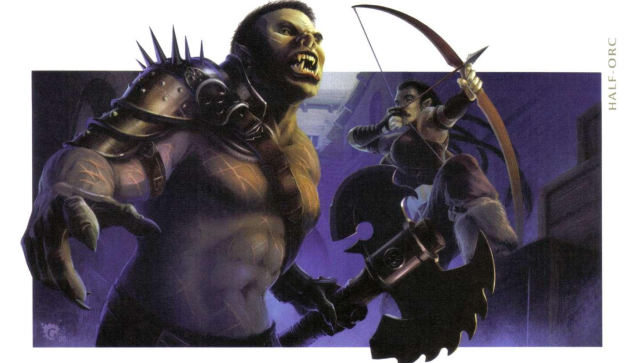
Copyright 2009 Wizards of the Coast Half-Orcs have been in the game since the days of AD&D, where they appeared as a playable option in the Player’s Handbook. Historically, they were one of the first “edgy” options for players, but they’ve always been a bit controversial and surrounded by Unfortunate Implications. The main one being that most versions of them implied that there was only one very unpleasant way in which an orc and a human could have a child.
In more recent years, several different solutions to this have been proposed. Some remove half-orcs from the game, others say they’re full orcs and that’s what a full orc looks like. Fourth Edition went with a third common option, which is to diversify the origins of half-orcs.
They appear as a playable option in the PHB 2, and have their NPC/enemy-style entries here.
The Lore
Half-Orcs as a people tend to combine the daring and ambition of humans with the strength and ferocity of orcs. Their build and features are orcish, but their hair and skin tones resemble those of humans rather than the greens and blues this edition uses for orcs.
Half-orcs are as numerous as any other people without “half-“ in their name. They have their own communities and cultures, and also live in more cosmopolitan settlements along with other sapients. You could play a half-orc who has neither humans nor orcs anywhere in their family tree, or at least none in living memory. In fact, they’ve been around in this state for so long that no one knows their true origins.
There are several competing theories. A more mythical version says that they arose when Gruumsh lost his eye and his spilled blood hit the world. Another myth says Kord created them by copying the best elements from his two favorite species. Others say they started out as a super-soldier experiment by an evil wizard, or when human and orc barbarian tribes joined in alliance in ancient times. Another still says they were engineered by the ancient goblin empire to act as orc wranglers.
And of course, you can still have a half-orc who’s the product of a happy marriage between a human and an orc. If you really want to you could also make a half-orc PC with the classic “Unfortunate” origin, but now it’s no longer exclusive to them. If you really want to play an edgy character, there are better options around these days.
Another thing that has been removed this edition is the “caught between two worlds, hated by both” cliche that used to plague both half-elves and half-orcs. And to that I say good riddance.
The Numbers
NPC Half-Orcs have the same signature traits as their playable version: low-light vision, a +2 bonus to speed when charging, and the Furious Assault encounter power. This can be used as a free action right after the half-orc hits an enemy, and increases the damage of the attack by 1d10. It’s a bit better than the PC version, which only increases it by 1d8.
Half-Orc Hunter
A ranger-type who really likes to jump into melee combat, fighting in a reckless manner. Wearing light armor, they carry a battleaxe and a longbow into combat.
The axe and the bow are basic attacks, and Evasive Chop allows the hunter to shift 1 square before making an axe attack. Draw First Blood is a passive trait that increases their damage against any enemy who hasn’t yet taken damage in this fight. Combining it with Furious Assault makes for a good “alpha strike”.
Half-Orc Death Mage
The death mage is more of a priest-type, serving an exarch of Gruumsh named Yurtrus. Yurtrus presides over disease, misery, and death, so their magic follows the same themes. Death Mages are always Evil, unlike the others here who are presented as Unaligned. They wear robes and carry quarterstaffs that work more as implements than as weapons.
Though they can attack with that staff, their main melee attack is a rotting touch that targets Fortitude and does both immediate and ongoing necrotic damage (save ends). The touch also strips any necrotic resistance or immunity the target might have! This opens it up to necrotic attacks from others, and allows that ongoing damage to have an effect. Saving against the damage also ends this condition.
At range, they can shoot Bolts of Putrescence vs. Reflex that deal physical damage and inflict a -5 penalty to all the target’s defenses for a turn. Their area attack is a Swarm of Flies that deals physical damage and creates a zone over the affected area. Anyone caught inside takes damage from fly bites, and has their visibility restricted to 3 squares. The death mage can move the zone 2 squares as a minor action.
The death mage has the racial Furious Assault power, and it’s worth remembering that it can enhance any attack, not just physical ones. Its final power is Death Mark, which automatically deals heavy physical damage to whoever reduces the mage to 0 HP.
Half-Orc Scarthane
Scarthanes are veteran warriors that eschew armor and proudly display the tapestry of scars covering their skin. The more wounded they are, the more dangerous they become, and either ferocity or blood magic allows them to keep fighting even through all those wounds.
A Scarthane is a Level 7 Brute with 96 HP, wielding a greataxe and fighting unarmored. The axe is a High-Crit weapon, and they’re limited to basic attacks and Furious Assault at first.
When the scarthane hits a bloodied target, Blood for Blood makes the attack deal +1d6 damage and heals them for 5 HP.
Once the scarthane becomes bloodied, Wounded Retaliation allows them to make a basic attack against whoever bloodied them. They also gain Bloodfury Attack, an axe attack that lacks the High-Crit property but deals more base damage and heals the scarthane for 10 HP when it hits. This does stack with Blood for Blood!
Sample Encounters and Final Impressions
Half-orcs can be found among humans, orcs, or other creatures that associate with them. They can easily be reskinned by replacing their signature traits with those of the target species.
The sample encounters are:
-
Level 6: 2 half-orc hunters, 1 human hexer, 4 human berserkers. A barbarian hunting party.
-
Level 9: 4 scarthanes, 1 orc chieftain, 1 orc eye of Gruumsh. The scarthanes make an excellent honor guard.
-
-
Let's Read the 4e Monster Manual 2: Half-Elf
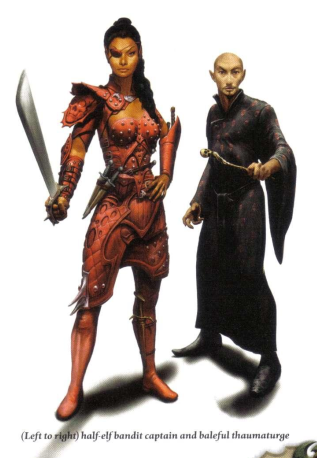
Copyright 2009 Wizards of the Coast Half-elves have been a part of D&D since races were first separated from classes back in AD&D 1st Edition. I guess they might have been inspired by Elrond from Lord of the Rings, who was said to be a half-elf. They appeared as a playable option right in the first PHB, but they’re only getting their monster/NPC entries here.
The Lore
I’m happy to report that Fourth Edition half-elves no longer follow the tired and somewhat problematic “outsiders to both parent cultures” narrative from previous editions! In fact, everyone likes them!
You see, half-elves aren’t just an “average” of their two parents. Yes, they’re sturdier than elves and pointier than humans, but they also have a lot of traits that are uniquely their own. Chief among those is a noticeable facility with social interaction and cultural adaptability.
Half-elves whose parents are a human and an elf can spend their early years in either of the two cultures, depending on their specific family circumstances. Their names and mannerisms tend to be taken from that culture. You can also have all-half-elf cultures and communities whose human and elven ancestors are several generations behind them. In all cases it’s very common for individuals to journey abroad for a while out of a sense of curiosity and wanderlust, and they tend to fit in well in any place where they linger for a while.
Of course, “Nice” doesn’t necessarily mean “Good”, and you can also find villainous half-elves who become bandit leaders or fall in with dark forces. They’re technically better-suited to be infernal warlocks than tieflings, given their stat adjustments.
The Numbers
We get three stat blocks here, more suitable for use as opposition than as allies, though they could also fill that role in a more morally ambiguous adventure.
Half-elves are Medium Natural humanoids, with a native speed of 6 and low-light vision. Everything else about their stat blocks comes from training.
Half-Elf Bandit Captain
This could be a murderous marauder or a Robin Hood figure. They’re a level 6 Skirmisher with the Leader keyword and 69 HP. They wear light armor, wield a sword, and carry a bunch of throwing daggers.
The sword is a basic melee attack that allows the captain to shift 1 square on a hit. Their basic ranged attack is a thrown dagger. A maneuver named Slash and Dash (recharge 4+) allows them to make a sword attack, shift 2 squares and throw a dagger. Their leaderly move is named Triggering Slash (recharge 5+), a sword attack that on a hit allows an ally to shift 1 square and make a melee basic attack of their own.
Half-Elf Con Artist
This is a Level 7 Controller with 77 HP. Whether they’re a lovable rogue or a dastardly deceiver depends on which side of the con you’re on. The con artist goes unarmored and clad in fine clothes, with a dagger hidden somewhere for protection. They’re trained in all the skills you’d expect them to have: Stealth, Bluff, Thievery, and Insight.
That dagger isn’t anything special, but it deals extra sneak attack damage if the con artist has combat advantage against the target. Their real weapon is manipulation, though. This is implemented as a trio of charm powers that target Will. It’s up to you whether they’re actual magic or just the con artist being very sly and convincing.
Deceptive Maneuver is an at-will melee power that causes the target to make a melee basic attack against an ally of the half-elf’s choice. The classic “getting between two enemies to make them hit each other”.
Silver Deception (ranged 10; recharge 5+) does no damage, but dominates the target until the end of the con artist’s next turn.
And Pathetic Appeal is an encounter power that targets every enemy in a close burst 5 and, on a hit, prevents them from attacking the con artist until they pass a save. If the con artist makes an attack roll against an affected target, they get an immediate extra save against this effect. “I’ve seen the error of my ways, honest!”
To close things out, Grifter’s Flight is another encounter power that allows the con artist to shift 6 squares and make an unpenalized Stealth check at the end
Half-Elf Baleful Thaumaturge
An epic-level evil wizard for all of your epic-level evil wizard needs. The stat block itself is Unaligned, so you could also use it to represent a wizard that’s merely edgy. No reason it has to be a half-elf either, the stats could apply to any Medium sapient. Their magic has a “blood and teeth” theme, which gives you a hint as to what kind of entity they learned it from.
The thaumaturge is Level 24 Artillery with 169 HP. They go unarmored, and wield a wand as an implement. Their basic melee attack is an Infernal Slam that targets Will. A hit damages the target, pushes it 3 squares, and allows the thaumaturge to teleport 3 squares. Their basic ranged attack is a Soul Bite spell (ranged 10 vs. Reflex) that does physical damage and gives the thaumaturge 10 temporary HP on a hit.
The “bitey” theme continues with their two special attacks. Wall of Shadow Teeth (recharge 5+) creates wall 2 squares high and 8 squares long within 10 squares of the caster. This wall bites, attacking anyone adjacent to it. A hit deals necrotic damage and immobilizes the target (save ends). It lasts for a turn but can be sustained with minor actions.
Mouths of Hell (close blast 5 vs. Will; encounter) deals heavy psychic damage and also gives the thaumaturge 10 temporary HP. This creates a zone of ghostly maws that lasts until the end of the encounter, deals 15 psychic damage to anyone caught inside, and gives the caster 5 temporary HP when it damages someone in this way.
The thaumaturge can also spend 5 temporary HP if it has them to teleport 8 squares as a minor action, with a spell called Bloody Step.
Sample Encounters and Final Impressions
There isn’t much of a theme to the half-elves in this entry, but I guess that’s the point. They’re as varied as humanity. Each individual entry has their own thing going.
The two sample encounters we get are a Level 7 one with a bandit captain leading a gang of humans and halflings, and a Level 25 one with an epic lich and its entourage of 2 thaumaturges and 2 slaughterstone hammerers.
subscribe via RSS